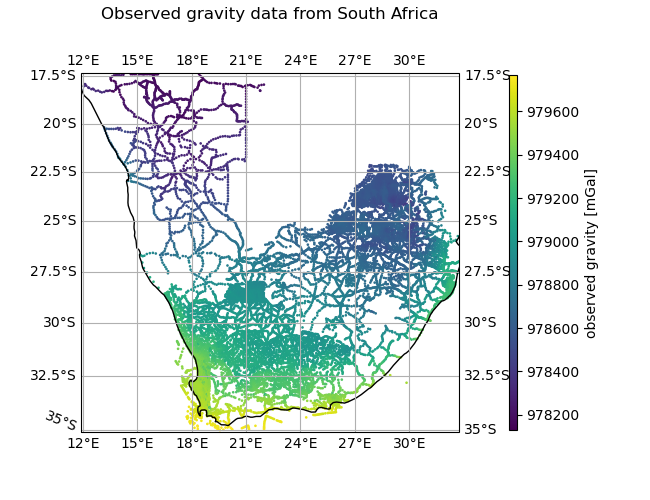Note
Click here to download the full example code
Land Gravity Data from South Africa¶
Land gravity survey performed in January 1986 within the boundaries of the
Republic of South Africa. The data was made available by the National Centers
for Environmental Information (NCEI) (formerly
NGDC) and are in the public domain. The
entire dataset is stored in a pandas.DataFrame with columns:
longitude, latitude, elevation (above sea level) and gravity(mGal). See the
documentation for harmonica.datasets.fetch_south_africa_gravity for
more information.

Out:
latitude longitude elevation gravity
0 -34.39150 17.71900 -589.0 979724.79
1 -34.48000 17.76100 -495.0 979712.90
2 -34.35400 17.77433 -406.0 979725.89
3 -34.13900 17.78500 -267.0 979701.20
4 -34.42200 17.80500 -373.0 979719.00
... ... ... ... ...
14554 -17.95833 21.22500 1053.1 978182.09
14555 -17.98333 21.27500 1033.3 978183.09
14556 -17.99166 21.70833 1041.8 978182.69
14557 -17.95833 21.85000 1033.3 978193.18
14558 -17.94166 21.98333 1022.6 978211.38
[14559 rows x 4 columns]
import matplotlib.pyplot as plt
import cartopy.crs as ccrs
import verde as vd
import harmonica as hm
# Fetch the data in a pandas.DataFrame
data = hm.datasets.fetch_south_africa_gravity()
print(data)
# Plot the observations in a Mercator map using Cartopy
fig = plt.figure(figsize=(6.5, 5))
ax = plt.axes(projection=ccrs.Mercator())
ax.set_title("Observed gravity data from South Africa", pad=25)
tmp = ax.scatter(
data.longitude,
data.latitude,
c=data.gravity,
s=0.8,
cmap="viridis",
transform=ccrs.PlateCarree(),
)
plt.colorbar(
tmp, ax=ax, label="observed gravity [mGal]", aspect=50, pad=0.1, shrink=0.92
)
ax.set_extent(vd.get_region((data.longitude, data.latitude)))
ax.gridlines(draw_labels=True)
ax.coastlines()
plt.show()
Total running time of the script: ( 0 minutes 0.430 seconds)